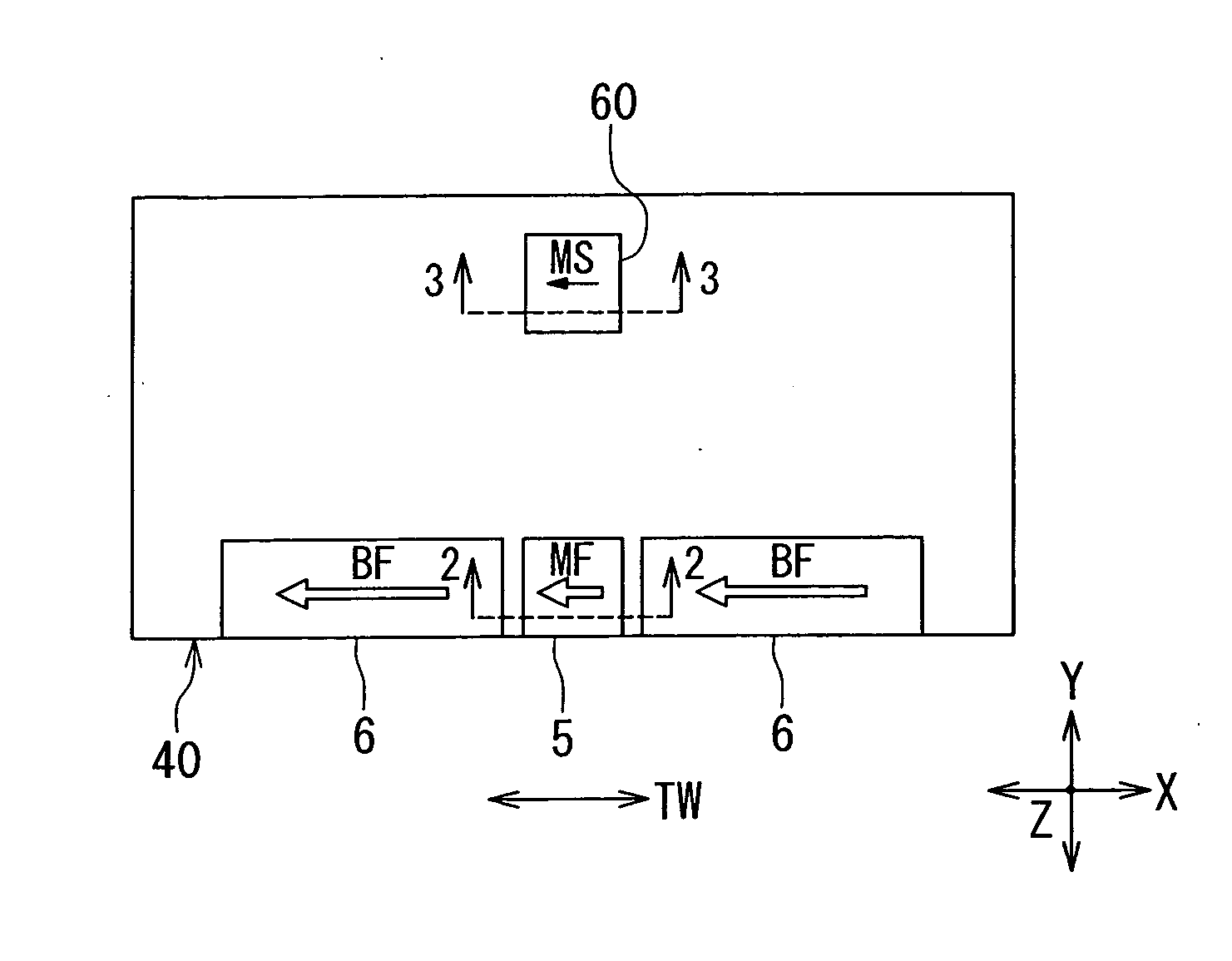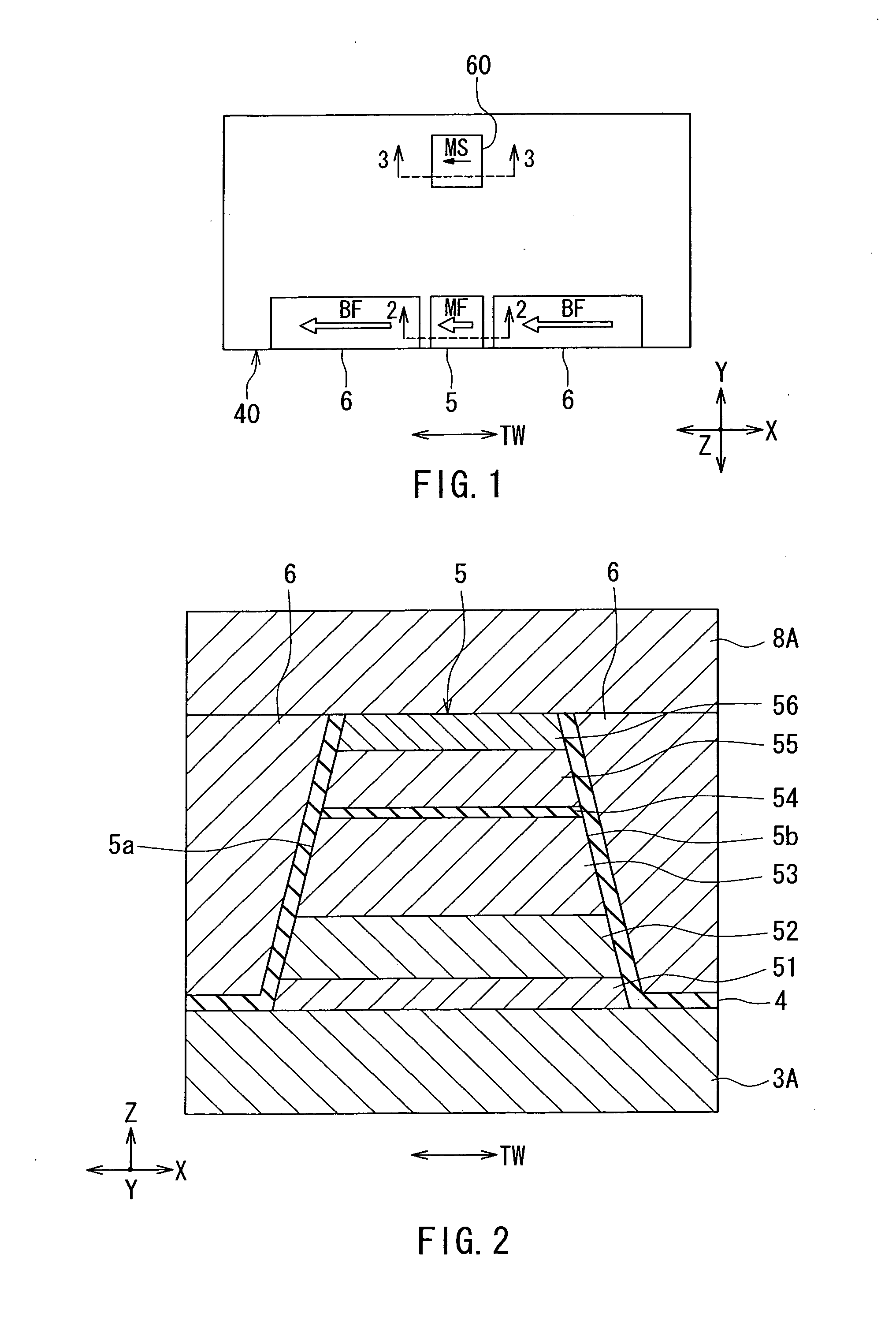Magnetic detector including magnetoresistive element and impact sensor
a technology of impact sensor and magnetic head, which is applied in the manufacture of flux-sensitive heads, instruments, and recording information storage, etc., can solve the problems of difficult to detect a collision of the magnetic head and the recording medium, the magnetic head may collide with and the protruding protruding head
- Summary
- Abstract
- Description
- Claims
- Application Information
AI Technical Summary
Benefits of technology
Problems solved by technology
Method used
Image
Examples
first embodiment
[0045]Embodiments of the present invention will now be described in detail with reference to the drawings. Reference is first made to FIG. 6 to describe a slider 210 including a thin-film magnetic head according to a first embodiment of the present invention. In a magnetic disk drive the slider 210 is placed to face toward a circular-plate-shaped recording medium (a magnetic disk platter) that is driven to rotate. In FIG. 6 the X direction is across the tracks of the recording medium, the Y direction is perpendicular to the surface of the recording medium, and the Z direction is the direction of travel of the recording medium as seen from the slider 210. The X, Y and Z directions are orthogonal to one another. The slider 210 has a base body 211. The base body 211 is nearly hexahedron-shaped. One of the six surfaces of the base body 211 is designed to face toward the surface of the recording medium. At this one of the six surfaces, there is formed a medium facing surface 40 to face t...
second embodiment
[0125]Reference is now made to FIG. 19 to describe a second embodiment of the present invention. FIG. 19 is a plan view showing a main part of a magnetic detector according to the second embodiment. In the second embodiment, as shown in FIG. 19, two bias magnetic field applying layers 6B for the sensor are provided on opposite sides of the impact sensor 60 in the track width direction, with insulating films (not shown) provided between the impact sensor 60 and the respective layers 6B. The bias magnetic field applying layers 6B for the sensor generate a bias magnetic field for the sensor in the track width direction. The magnetization direction of the impact detecting layer 65 in the initial state is directed to the track width direction by the bias magnetic field for the sensor. In FIG. 19 the arrows ‘BS’ indicate the direction of the bias magnetic field for the sensor generated by the bias magnetic field applying layers 6B for the sensor.
[0126]The bias magnetic field applying laye...
third embodiment
[0129]Reference is now made to FIG. 20 to describe a third embodiment of the present invention. FIG. 20 is a plan view showing a main part of a magnetic detector according to the third embodiment. In the third embodiment, as in the second embodiment, two bias magnetic field applying layers 6B for the sensor are provided on opposite sides of the impact sensor 60 in the track width direction with insulating films 4B provided between the impact sensor 60 and the respective layers 6B, as shown in FIG. 20. The bias magnetic field applying layers 6B for the sensor generate a bias magnetic field for the sensor in the track width direction. In the third embodiment the length of the bias magnetic field applying layers 6B for the sensor taken in the track width direction is equal to the length of the bias magnetic field applying layers 6 taken in the track width direction. The magnitude of the bias magnetic field for the sensor is equal to or nearly equal to the magnitude of the bias magnetic...
PUM
| Property | Measurement | Unit |
|---|---|---|
| distance | aaaaa | aaaaa |
| distance | aaaaa | aaaaa |
| magnetoresistive | aaaaa | aaaaa |
Abstract
Description
Claims
Application Information
 Login to View More
Login to View More - R&D
- Intellectual Property
- Life Sciences
- Materials
- Tech Scout
- Unparalleled Data Quality
- Higher Quality Content
- 60% Fewer Hallucinations
Browse by: Latest US Patents, China's latest patents, Technical Efficacy Thesaurus, Application Domain, Technology Topic, Popular Technical Reports.
© 2025 PatSnap. All rights reserved.Legal|Privacy policy|Modern Slavery Act Transparency Statement|Sitemap|About US| Contact US: help@patsnap.com



